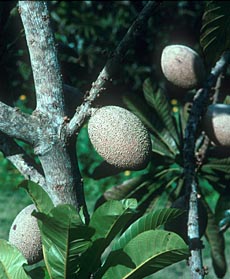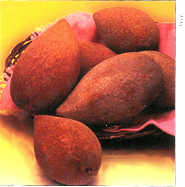
Mamey Sapote
Pouteria sapota

Mamey sapote is a tropical native from Mexico and Central America. It is also found in Puerto Rico, Cuba, the Dominican Republic, South America, and South Florida, USA. The mamey sapote tree is a tall tree with large spreading leaves and small white flowers. In order to bear their fruit, mamey sapote trees must be mature, which they become after the age of 3 years from grafting. Once the trees mature, they produce 150 to 250 fruits per year and weigh anywhere from 1-5 lbs, depending on the cultivar.
The mamey sapote fruit is oval shaped, similar to a football, and is 3-8 inches in length. Its skin is thick, woody, and brown in color, and its flesh has an orange-reddish tint. The mamey sapote harvest in Florida is from January to April and from June to September. When purchasing mamey sapote, make sure that its skin is free of blemishes and that it is firm and mature. You will know when a mamey sapote is ripe by looking near its stem for a small nick. This cut allows you to view inside to the mamey sapote's flesh. If the inside flesh is green in color, the mamey sapote is not mature. A mature mamey sapote should have an inner flesh that is red-brown in color. To ripen them at your home you will need to leave them exposed to air at room temperature until the fruit softens. Ripened mamey sapote, can be stored in your home for up to one week if the fruit is refrigerated.

Although mamey sapote fruit can be eaten fresh, popular uses for it include adding it to fruit salads, desserts, milk shakes and other fruit drinks. It is also used commercially by some dairy product manufacturers to produce an exotic, tropical flavored ice cream. Because of its interesting taste and texture, the mamey sapote fruit is rapidly gaining in popularity for cooking purposes. Additionally, mamey sapote is high in vitamins A and C as well as in potassium. It is also an excellent source of dietary fiber. Regarding caloric content, one cup of mamey sapote contains approximately 135 calories.
The mamey sapote fruit can be used as a tasty addition to many desserts and drinks. Its appearance in markets and in commercial products will continue to increase because of this fruit's nutritional benefits and its exotic appeal to chefs.